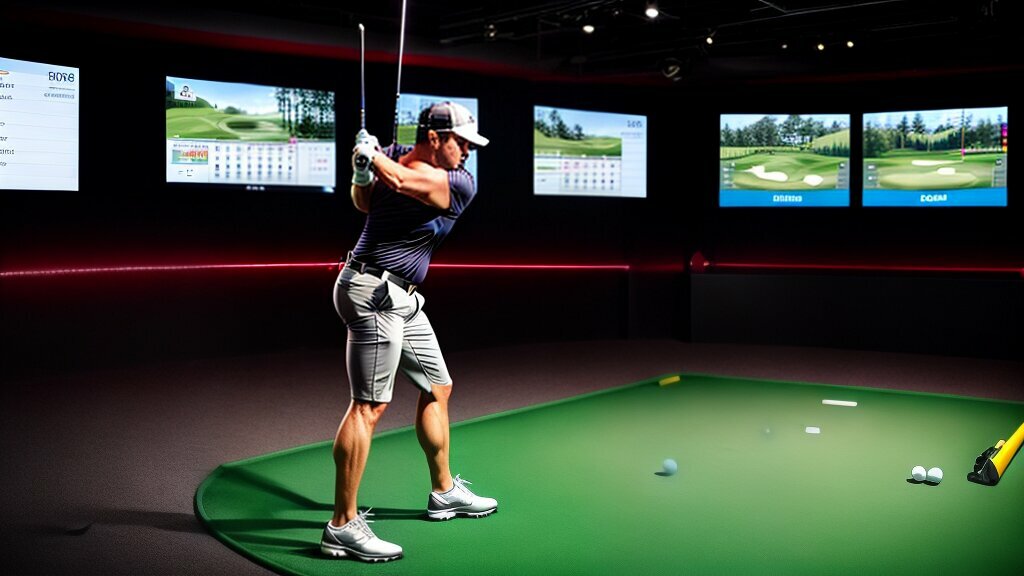As a golf enthusiast and a professional journalist, I have often wondered about the accuracy of golf simulators. With technology advancing rapidly, golf simulators have become a popular option for both amateurs and professionals to practice their skills off the course.
However, the question remains – how accurate are these simulators?
In this article, I will delve into the factors that determine the accuracy of golf simulators, explain the precision of modern simulators, and explore the various factors that can affect their accuracy.
By the end of this article, you will gain a comprehensive understanding of the accuracy and potential of golf simulators in improving your game.
Key Takeaways
- Golf simulators have become a popular option for golfers to practice their skills off the course.
- The accuracy of golf simulators depends on various factors, including technology, calibration, and precision measurements.
- The precision of golf simulators is evaluated based on clubhead speed, ball speed, launch angle, and spin rate.
- The setup of the simulator, environmental factors, and potential discrepancies can affect the accuracy of golf simulators.
- Golf simulators can be a valuable tool for improving your game, but it’s important to be aware of their limitations.
Golf Simulator Accuracy Overview
When it comes to golf simulators, accuracy is paramount. Golfers need to receive realistic feedback on their swings to improve their game. But how do simulators measure accuracy?
Modern golf simulators use a combination of sensors and high-speed cameras to capture data on the golfer’s swing. The sensors measure the clubhead’s position, speed, and direction, while the cameras capture the ball’s launch angle, spin rate, and velocity. This data is then analyzed to provide accurate feedback on the player’s swing.
However, measuring accuracy is not as simple as just collecting data. Calibration is critical to ensure the accuracy of the simulation. The simulator must be calibrated to the individual golfer’s swing to provide the most accurate feedback possible. A properly calibrated simulator takes into account the unique characteristics of the player’s swing, such as their swing speed and clubface angle.
Factors Affecting Golf Simulator Accuracy
Several factors can affect the accuracy of golf simulators. One significant factor is the quality of the simulator setup, including the quality of the screen, projector, and hitting mat. A high-quality setup can provide a more accurate simulation, while a low-quality setup may introduce errors into the data.
Environmental factors can also impact accuracy. Lighting conditions, room dimensions, and temperature can all affect the simulation’s accuracy. For instance, poor lighting can make it difficult for cameras to capture accurate data, while a small room may restrict the golfer’s swing and affect the data collected.
Overall, understanding the technology behind golf simulators and the factors that impact their accuracy is essential for golfers looking to improve their game. While properly calibrated and high-quality simulators can provide accurate feedback, it’s essential to keep in mind the limitations and potential discrepancies that may arise.
Assessing Golf Simulator Precision
When it comes to evaluating the accuracy of golf simulators, precision is a critical factor. In the context of golf, precision refers to the ability of the simulator to provide detailed and accurate measurements of various swing parameters.
Clubhead speed, ball speed, launch angle, and spin rate are some of the critical factors that contribute to a realistic simulation. Each of these measurements is crucial in assessing the quality of a golf shot and optimizing technique. Therefore, it is essential to consider the precision of a golf simulator before purchasing or using one.
Golf simulators use various sensors and cameras to track and measure the different parameters of a swing. The sensors collect data on the movement and position of the club, while the cameras capture images and provide insights into the flight of the ball. The accuracy of these sensors and cameras has a direct impact on the precision of the simulator.
| Golf Swing Parameters | Description |
|---|---|
| Clubhead Speed | The speed at which the clubhead is moving at the point of impact with the ball. |
| Ball Speed | The speed at which the ball is traveling just after impact with the clubface. |
| Launch Angle | The angle at which the ball lifts off from the clubface. |
| Spin Rate | The amount of spin on the ball measured in revolutions per minute (RPM). |
While most modern golf simulators have high levels of precision, it is worth noting that some factors can affect their performance. For example, inconsistencies in the hitting mat can cause discrepancies in measurement, and lighting conditions can affect the accuracy of the camera feed. Therefore, it is essential to ensure that the simulator’s setup is optimal and consistent to achieve maximum precision.
In conclusion, assessing the precision of a golf simulator is crucial in evaluating its accuracy. By understanding the critical parameters that contribute to a realistic simulation, golfers can make informed decisions about the quality of the simulator they use. Additionally, it is essential to consider the factors that can impact precision, such as hitting mat quality and lighting, to ensure optimal performance.
Factors Affecting Golf Simulator Accuracy
There are several factors that can impact the accuracy of golf simulators. Proper setup, including the quality of the screen, projector, and hitting mat, is critical to ensure reliable data collection. A low-quality projector or screen can distort images and impact the accuracy of the measurements. Similarly, a suboptimal hitting mat can result in inaccurate readings and may cause damage to clubheads.
Environmental factors also play a role in simulator accuracy. Lighting conditions, room dimensions, and temperature can all impact the simulation’s realism. Too much or too little light can affect the visibility of the ball and the clubhead, while a poorly ventilated room may affect the performance of the sensors and cameras that capture swing data. Moreover, a small room may not allow for proper club movement, resulting in inaccurate swing measurements.
It’s worth noting that the accuracy of golf simulators can vary depending on the technology used, the number and quality of sensors, and the type of simulation software. Some simulators provide more accurate data than others, and it’s important to consider the quality of the technology before investing in a simulator.
In summary, golf simulator accuracy can be affected by a range of factors, both external and internal. By understanding these factors, players can optimize their simulator setup to ensure the most accurate and realistic simulation possible, leading to improved performance on the course.
Conclusion
In conclusion, golf simulators have come a long way in terms of accuracy and precision. With advancements in technology and sophisticated measurement systems, golfers can now rely on simulators to provide a realistic and reliable experience that can improve their game. However, it is important to acknowledge that there are several factors that can affect simulator accuracy, such as the environment and setup.
Despite these limitations, golfers can still benefit greatly from using simulators in their training and practice sessions. Whether it’s analyzing their swing mechanics or measuring their performance metrics, golf simulators can provide invaluable insights into a player’s game that can help them improve in real-life scenarios.
As with any technology, it’s important to approach golf simulators with a critical eye and a willingness to adapt to any discrepancies or imperfections that may arise. But when used effectively, golf simulators can be a valuable tool in enhancing a golfer’s skills and preparing them for any challenges they may face on the course.





Leave a Reply